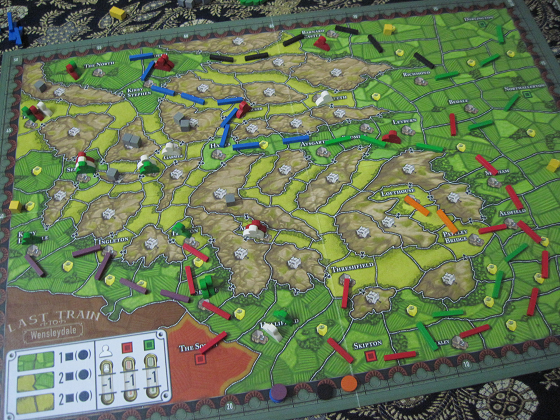
Since we only played the England side of the board, I guess maybe this should still be called Last Train to Wensleydale. Fun fact: I was confused while looking up this game. After all, why is it Last Train to Wensleydale but First Train to Nuremberg. It turns out that there is a song called Last Train to Nuremberg. Weird. Anyway, this is yet another of Martin Wallace’s train games in which you run a railway company and ship goods and passengers to make money. Some thoughts:
- On the surface, the rules sound like they’re terribly complicated. Each player has a set of black investment cubes, but there are also four tracks, white, brown, red and green respectively, denoting different types of influence. This influence can not be spent to do various things, they also determine turn order for the different phases of the game. But once play actually started, it’s not that hard, at least leaving aside my color blindness problems with how similar the brown-red-green hues look to my eyes.
- I think I found it to be not that difficult because there seems to be less planning ahead in this game. Really, you just want to ship as many things as possible and other than train capacity, there are no limits no how many goods you can ship. It’s not like Steam etc. in which your engine level limits how far you can ship something. Here, you can ship goods however far you want, so long as your tracks can reach it. Plus, track maintenance costs mean that you usually want to sell off your tracks whenever possible, so you sort of start anew every turn.
- A lot of Wallace’s games impose some kind of upkeep cost that forces you to sprint just to keep up. It’s a great source of tension in his designs. The track maintenance costs play that role here but they feel weak since you’re allowed to sell your track to the big railway companies and get rid of them that way. It’s as if Steam allowed you to redeem the bonds you issued to investors. Another factor is that the initial auction for influence and most of the track laying is paid for using the investment cubes instead of money, and everyone gets a fixed 12 investment cubes per turn. It’s not tied to the income track and because each player has only 15 cubes in total, you can’t really save much from turn to turn either.
- Maybe the problem with our session was that we weren’t aggressive enough in the auction phase. We didn’t even have auctions worthy of the title most of time. Since each player can only grab two sets of influence max, and there are a total of eight sets available, just enough for each of the four of us, we almost always got away with just paying the minimum cost for them. This gave us plenty of cubes left to build tracks. The bottleneck wasn’t the cost of laying tracks, it was having enough green or red influence to sell the tracks after we were done using them.
- The train renting phase is one part of the game I liked. It’s cool to see the board with all sorts of configurations of trains since in this game, goods and passengers need completely different carriages. Each specific configuration can only be rented by one player, so it’s quite important to get the one you really need or you’ll need to spend extra brown influence to rent more capacity than you actually need to ship your stuff.
- One way to get points is to ship enough to complete sets of goods and passengers. This ended up being the most important for me, but it feels like an odd and not really thematic rule. I guess it encourages players to try to spread around and access different things, especially since the red and the green towns are on separate parts of the map and you need to work to be able to ship both green and red passengers but it feels artificial and arbitrary.
- Finally, since you have no limits on how far you can ship goods and you can’t really build up your railway over the course of the game, the net effect is that the turn in which players manage to ship the most goods is the very first turn, when the board is most full of stuff. Unlike most games in which you start slow and then build up to a climax, this makes First Train to Nuremberg kind of end with a whimper instead of a bang.
All this means that I ended up feeling that I must have missed something, especially since we only used a very small part of the scoring track. While it’s still reasonably fun, I don’t see anything special in this game or why anyone would choose to play this instead of one of Wallace’s many other games. It just feels lacking in tension and excitement.

Leave a Reply